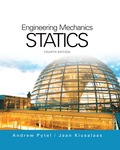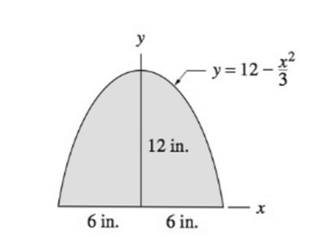
International Edition---engineering Mechanics: Statics 4th Edition
4th Edition
ISBN: 9781305856240
Author: Pytel
Publisher: Cengage
expand_more
expand_more
format_list_bulleted
Concept explainers
Textbook Question
Chapter 9, Problem 9.7P
Determine

Expert Solution & Answer
Want to see the full answer?
Check out a sample textbook solution
Students have asked these similar questions
Blood (HD = 0.45 in large diameter tubes) is forced through hollow fiber tubes that are 20 µm in diameter.Equating the volumetric flowrate expressions from (1) assuming marginal zone theory and (2) using an apparentviscosity for the blood, estimate the marginal zone thickness at this diameter. The viscosity of plasma is 1.2 cP
Q2: Find the shear load on bolt A for the
connection shown in Figure 2.
Dimensions are in mm
Fig. 2
24
0-0
0-0
A
180kN
(10 Mark
determine the direction and magnitude of angular velocity ω3 of link CD in the four-bar linkage using the relative velocity graphical method
Chapter 9 Solutions
International Edition---engineering Mechanics: Statics 4th Edition
Ch. 9 - Compute the moment of inertia of the shaded region...Ch. 9 - The properties of the plane region are...Ch. 9 - The moments of inertia of the plane region about...Ch. 9 - The moment of inertia of the plane region about...Ch. 9 - Using integration, find the moment of inertia and...Ch. 9 - Use integration to determine the moment of inertia...Ch. 9 - Determine Ix and Iy for the plane region using...Ch. 9 - Using integration, compute the polar moment of...Ch. 9 - Use integration to compute Ix and Iy for the...Ch. 9 - By integration, determine the moments of inertia...
Ch. 9 - Compute the moment of inertia about the x-axis for...Ch. 9 - By integration, find the moment of inertia about...Ch. 9 - Figure (a) shows the cross section of a column...Ch. 9 - Compute the dimensions of the rectangle shown in...Ch. 9 - Compute Ix and Iy for the W867 shape dimensioned...Ch. 9 - Figure (a) shows the cross-sectional dimensions...Ch. 9 - A W867 section is joined to a C1020 section to...Ch. 9 - Compute Ix and Iy for the region shown.Ch. 9 - Prob. 9.19PCh. 9 - Calculate Ix for the shaded region, knowing that...Ch. 9 - Compute Iy for the region shown, given that...Ch. 9 - Prob. 9.22PCh. 9 - Prob. 9.23PCh. 9 - Determine Ix for the triangular region shown.Ch. 9 - Determine the distance h for which the moment of...Ch. 9 - A circular region of radius R/2 is cut out from...Ch. 9 - Prob. 9.27PCh. 9 - Determine the ratio a/b for which Ix=Iy for the...Ch. 9 - As a round log passes through a sawmill, two slabs...Ch. 9 - Prob. 9.30PCh. 9 - By numerical integration, compute the moments of...Ch. 9 - Use numerical integration to compute the moments...Ch. 9 - The plane region A is submerged in a fluid of...Ch. 9 - Use integration to verify the formula given in...Ch. 9 - For the quarter circle in Table 9.2, verify the...Ch. 9 - Determine the product of inertia with respect to...Ch. 9 - The product of inertia of triangle (a) with...Ch. 9 - Prob. 9.38PCh. 9 - For the region shown, Ixy=320103mm4 and Iuv=0....Ch. 9 - Prob. 9.40PCh. 9 - Calculate the product of inertia with respect to...Ch. 9 - Prob. 9.42PCh. 9 - Prob. 9.43PCh. 9 - The figure shows the cross section of a standard...Ch. 9 - Prob. 9.45PCh. 9 - Prob. 9.46PCh. 9 - Prob. 9.47PCh. 9 - Use numerical integration to compute the product...Ch. 9 - Determine the dimension b of the square cutout so...Ch. 9 - For the rectangular region, determine (a) the...Ch. 9 - Prob. 9.51PCh. 9 - Prob. 9.52PCh. 9 - Prob. 9.53PCh. 9 - Prob. 9.54PCh. 9 - Prob. 9.55PCh. 9 - The u- and v-axes are the principal axes of the...Ch. 9 - The x- and y-axes are the principal axes for the...Ch. 9 - Prob. 9.58PCh. 9 - The inertial properties of the region shown with...Ch. 9 - Determine Iu for the inverted T-section shown....Ch. 9 - Using Ix and Iu from Table 9.2, determine the...Ch. 9 - Show that every axis passing through the centroid...Ch. 9 - Prob. 9.63PCh. 9 - The L806010-mm structural angle has the following...Ch. 9 - Compute the principal centroidal moments of...Ch. 9 - Prob. 9.66PCh. 9 - Determine the principal axes and the principal...Ch. 9 - Compute the principal centroidal moments of...Ch. 9 - Find the moments and the product of inertia of the...Ch. 9 - Determine the moments and product of inertia of...Ch. 9 - Find the principal moments of inertia and the...Ch. 9 - Determine the moments and product of inertia of...Ch. 9 - Prob. 9.73PCh. 9 - Prob. 9.74PCh. 9 - The u- and v-axes are the principal axes of the...Ch. 9 - The x- and y-axes are the principal axes for the...Ch. 9 - Prob. 9.77PCh. 9 - The L806010-mm structural angle has the following...Ch. 9 - Prob. 9.79RPCh. 9 - Prob. 9.80RPCh. 9 - By integration, show that the product of inertia...Ch. 9 - Compute Ix and Iy for the shaded region.Ch. 9 - Using integration, evaluate the moments of inertia...Ch. 9 - The inertial properties at point 0 for a plane...Ch. 9 - Compute Ix and Iy for the shaded region.Ch. 9 - The flanged bolt coupling is fabricated by...Ch. 9 - Prob. 9.87RPCh. 9 - Compute Ix,Iy, and Ixy for the shaded region.Ch. 9 - Determine Ix and Ixy for the shaded region shown.Ch. 9 - Calculate Ix,Iy, and Ixy for the shaded region...Ch. 9 - For the shaded region shown, determine (a) Ix and...Ch. 9 - Use integration to find Ix,Iy, and Ixy for the...Ch. 9 - Determine the principal moments of inertia and the...Ch. 9 - The properties of the unequal angle section are...
Knowledge Booster
Learn more about
Need a deep-dive on the concept behind this application? Look no further. Learn more about this topic, mechanical-engineering and related others by exploring similar questions and additional content below.Similar questions
- Four-bar linkage mechanism, AB=40mm, BC=60mm, CD=70mm, AD=80mm, =60°, w1=10rad/s. Determine the direction and magnitude of w3 using relative motion graphical method. A B 2 3 77777 477777arrow_forwardFour-bar linkage mechanism, AB=40mm, BC=60mm, CD=70mm, AD=80mm, =60°, w1=10rad/s. Determine the direction and magnitude of w3 using relative motion graphical method. A B 2 3 77777 477777arrow_forwardThe evaporator of a vapor compression refrigeration cycle utilizing R-123 as the refrigerant isbeing used to chill water. The evaporator is a shell and tube heat exchanger with the water flowingthrough the tubes. The water enters the heat exchanger at a temperature of 54°F. The approachtemperature difference of the evaporator is 3°R. The evaporating pressure of the refrigeration cycleis 4.8 psia and the condensing pressure is 75 psia. The refrigerant is flowing through the cycle witha flow rate of 18,000 lbm/hr. The R-123 leaves the evaporator as a saturated vapor and leaves thecondenser as a saturated liquid. Determine the following:a. The outlet temperature of the chilled waterb. The volumetric flow rate of the chilled water (gpm)c. The UA product of the evaporator (Btu/h-°F)d. The heat transfer rate between the refrigerant and the water (tons)arrow_forward
- (Read image) (Answer given)arrow_forwardProblem (17): water flowing in an open channel of a rectangular cross-section with width (b) transitions from a mild slope to a steep slope (i.e., from subcritical to supercritical flow) with normal water depths of (y₁) and (y2), respectively. Given the values of y₁ [m], y₂ [m], and b [m], calculate the discharge in the channel (Q) in [Lit/s]. Givens: y1 = 4.112 m y2 = 0.387 m b = 0.942 m Answers: ( 1 ) 1880.186 lit/s ( 2 ) 4042.945 lit/s ( 3 ) 2553.11 lit/s ( 4 ) 3130.448 lit/sarrow_forwardProblem (14): A pump is being used to lift water from an underground tank through a pipe of diameter (d) at discharge (Q). The total head loss until the pump entrance can be calculated as (h₁ = K[V²/2g]), h where (V) is the flow velocity in the pipe. The elevation difference between the pump and tank surface is (h). Given the values of h [cm], d [cm], and K [-], calculate the maximum discharge Q [Lit/s] beyond which cavitation would take place at the pump entrance. Assume Turbulent flow conditions. Givens: h = 120.31 cm d = 14.455 cm K = 8.976 Q Answers: (1) 94.917 lit/s (2) 49.048 lit/s ( 3 ) 80.722 lit/s 68.588 lit/s 4arrow_forward
- Problem (13): A pump is being used to lift water from the bottom tank to the top tank in a galvanized iron pipe at a discharge (Q). The length and diameter of the pipe section from the bottom tank to the pump are (L₁) and (d₁), respectively. The length and diameter of the pipe section from the pump to the top tank are (L2) and (d2), respectively. Given the values of Q [L/s], L₁ [m], d₁ [m], L₂ [m], d₂ [m], calculate total head loss due to friction (i.e., major loss) in the pipe (hmajor-loss) in [cm]. Givens: L₁,d₁ Pump L₂,d2 오 0.533 lit/s L1 = 6920.729 m d1 = 1.065 m L2 = 70.946 m d2 0.072 m Answers: (1) 3.069 cm (2) 3.914 cm ( 3 ) 2.519 cm ( 4 ) 1.855 cm TABLE 8.1 Equivalent Roughness for New Pipes Pipe Riveted steel Concrete Wood stave Cast iron Galvanized iron Equivalent Roughness, & Feet Millimeters 0.003-0.03 0.9-9.0 0.001-0.01 0.3-3.0 0.0006-0.003 0.18-0.9 0.00085 0.26 0.0005 0.15 0.045 0.000005 0.0015 0.0 (smooth) 0.0 (smooth) Commercial steel or wrought iron 0.00015 Drawn…arrow_forwardThe flow rate is 12.275 Liters/s and the diameter is 6.266 cm.arrow_forwardAn experimental setup is being built to study the flow in a large water main (i.e., a large pipe). The water main is expected to convey a discharge (Qp). The experimental tube will be built at a length scale of 1/20 of the actual water main. After building the experimental setup, the pressure drop per unit length in the model tube (APm/Lm) is measured. Problem (20): Given the value of APm/Lm [kPa/m], and assuming pressure coefficient similitude, calculate the drop in the pressure per unit length of the water main (APP/Lp) in [Pa/m]. Givens: AP M/L m = 590.637 kPa/m meen Answers: ( 1 ) 59.369 Pa/m ( 2 ) 73.83 Pa/m (3) 95.443 Pa/m ( 4 ) 44.444 Pa/m *******arrow_forward
- Find the reaction force in y if Ain = 0.169 m^2, Aout = 0.143 m^2, p_in = 0.552 atm, Q = 0.367 m^3/s, α = 31.72 degrees. The pipe is flat on the ground so do not factor in weight of the pipe and fluid.arrow_forwardFind the reaction force in x if Ain = 0.301 m^2, Aout = 0.177 m^2, p_in = 1.338 atm, Q = 0.669 m^3/s, and α = 37.183 degreesarrow_forwardProblem 5: Three-Force Equilibrium A structural connection at point O is in equilibrium under the action of three forces. • • . Member A applies a force of 9 kN vertically upward along the y-axis. Member B applies an unknown force F at the angle shown. Member C applies an unknown force T along its length at an angle shown. Determine the magnitudes of forces F and T required for equilibrium, assuming 0 = 90° y 9 kN Aarrow_forward
arrow_back_ios
SEE MORE QUESTIONS
arrow_forward_ios
Recommended textbooks for you
 International Edition---engineering Mechanics: St...Mechanical EngineeringISBN:9781305501607Author:Andrew Pytel And Jaan KiusalaasPublisher:CENGAGE L
International Edition---engineering Mechanics: St...Mechanical EngineeringISBN:9781305501607Author:Andrew Pytel And Jaan KiusalaasPublisher:CENGAGE L Precision Machining Technology (MindTap Course Li...Mechanical EngineeringISBN:9781285444543Author:Peter J. Hoffman, Eric S. Hopewell, Brian JanesPublisher:Cengage Learning
Precision Machining Technology (MindTap Course Li...Mechanical EngineeringISBN:9781285444543Author:Peter J. Hoffman, Eric S. Hopewell, Brian JanesPublisher:Cengage Learning

International Edition---engineering Mechanics: St...
Mechanical Engineering
ISBN:9781305501607
Author:Andrew Pytel And Jaan Kiusalaas
Publisher:CENGAGE L

Precision Machining Technology (MindTap Course Li...
Mechanical Engineering
ISBN:9781285444543
Author:Peter J. Hoffman, Eric S. Hopewell, Brian Janes
Publisher:Cengage Learning
Thermodynamics: Maxwell relations proofs 1 (from ; Author: lseinjr1;https://www.youtube.com/watch?v=MNusZ2C3VFw;License: Standard Youtube License